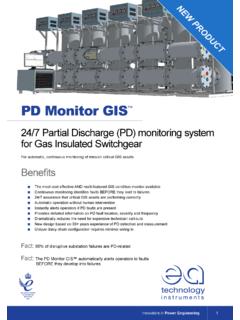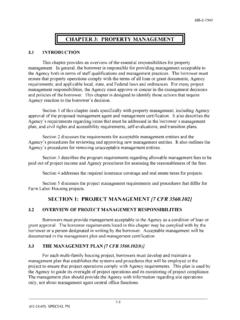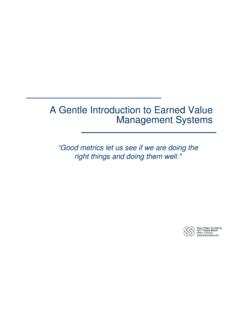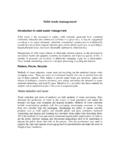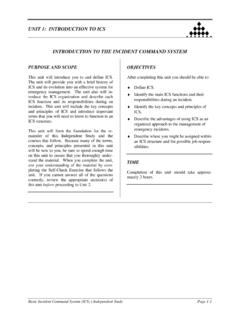Transcription of An Introduction to Asset Management - hvds.co.nz
1 An Introduction to Asset ManagementA simple but informative Introduction to the Management of physical assetsBy Robert DavisRecommendedThe Institute ofAsset ManagementPublished by blah d blah design ltdSubsidiary of EA Technology LtdCapenhurst Technology ParkCapenhurstChesterCH1 6ES Copyright Robert Davis 978-0-9571508-3-6 ForewordAs the serving President of the Institute of Asset Management , I am delighted to recommend this short a past President of the IAM, Robert brought to the subject of Asset Management his wealth of experience in business Management and marketing. This helped enormously in developing the IAM and the field of Asset Management , from a purely engineering and technical focus to one that recognises the need to engage across disciplines. Asset Management is increasingly well understood by the business community as a strategic and business led discipline, where the value of assets is their contribution to achieving explicit business you are encountering Asset Management for the first time, this book should be a helpful Introduction to the key topics.
2 It should also highlight the benefits which are there to be gained by understanding and applying the fundamental principles. Of course, if you become interested or need to know more there is a great deal to be explored and I look forward to welcoming you into our community! We are very grateful to Robert for making his book freely available and we would encourage you to pass it on to anyone you think might MorrisPresident of the Institute of Asset Management12An Introduction to Asset ManagementA simple but informative Introduction to the Management of physical assetsBy Robert DavisWe are all Asset managers. The last time you had your car serviced or decorated your house, you were managing an Asset !This book explores the discipline of Asset Management and demonstrates how it can be used to make better investment you work for a company that owns or manages physical assets?
3 Would you like to work for a utility? Or have you just heard the expression Asset Management and want to know more about it? If the answer to any of the above is Yes! , then this book is for does Asset Management matter? Why is it useful? How does it improve organisational effectiveness? How will it help me as an engineer, accountant, operational manager or director? This book will address these issues and signpost you to sources of information which can deepen your understanding and help you on your Asset Management writing this book, I have benefited from the wonderful intelligence and experience shared with me during my years as President of the Institute of Asset Management by a number of world leading experts in the field, as well as drawing on my twenty years plus experience of managing property, plant and equipment assets.
4 I am indebted to the people who have generously given their time to edit this document, including Paul Barnfather, Tom Elner, Madi and Deb Davis and Jo more information on the Institute of Asset Management , go to can be contacted via: Introduction6. What do we mean by physical Asset ?7. What Asset Management isn t10. Why is Asset Management important?11. The Asset life cycle13. Understanding risk15. So what does an Asset manager do?17. How good do you need to be?19. More subject areas21. Glossary of Asset Management terminology25. Where to Management of physical assets is like any other evolving Management discipline. It suffers from terminology overload. The newcomer to the subject may struggle to understand the basics. This is partly because of the unfamiliar context, but also because there are still relatively few people around to ask!
5 This book will give newcomers a starting point from which to develop their knowledge. For those just past the starting point, it might give some structure to their understanding. For the well-seasoned Asset managers out there, I hope it provides either a feeling of satisfaction, or better still, grounds for a good discussion!Managing assets effectively for utilities is not optional these days. Across the globe, every society is faced with a significant Asset Management challenge: Emerging economies are trying to identify the lowest cost / highest return investments to achieve maximum immediate benefit Rapidly developing countries are faced with understanding the life cycle costs of their infrastructure More mature economies are trying to find ways of extending the life of their infrastructure and also meet major global challenges like climate changeAsset Management thinking can provide structure to assist in all of these scenarios.
6 It can improve the quality of life for millions of people. It is an important cog in the big machine of our evolving civilisation. Done well, it impacts positively on the well-being of the planet and everything on do we mean by physical Asset ?1. Dictionary Definition of Asset Any item of economic value owned by an individual or corporation 2. Why physical Asset ? We ARE referring to items such as buildings, utility infrastructure such as electrical cables, water pipes, rail lines and metro tunnels, and industrial assets such as oil rigs, chemical plants and process plant conveyors We are NOT talking about financial assets, human assets or personal assets, as referred to in their normal context but we may be talking about non-physical things that affect these physical assets: skills, data, systems and software, for example3.
7 Other features of a physical Asset include Its value may be represented on a corporation s balance sheet It may be listed in a register ( Asset repository, see glossary) Its value normally depreciates over time Its condition normally deteriorates with time and / or use It is likely to benefit from good stewardship It plays some role or has a function in the delivery of a process or service There are often lots of similar items around the globe which can benefit from similar management7 What Asset Management isn t1. Asset Management : Is a mind-set which sees physical assets not as inanimate and unchanging lumps of metal / plastic / concrete, but as objects and systems which respond to their environment, change and normally deteriorate with use, and progressively grow old then fail / stop working / die!
8 Is a recognition that assets have a life cycle Is as important for those working in finance as it is for engineers Is an approach that looks to get the best out of the assets for the benefit of the organisation and/or its stakeholders Is about understanding and managing the risk associated with owning assetsOne of the challenges with managing an Asset is that it is not sentient. It does not keep Management edicts. It does not respond to the economy or politics. But it does respond to how it is treated and used. This creates a challenge for Management . How do you get the right behaviour from an entity that won t listen? 8A key principle in Asset Management is LINE OF means: An approach within an organisation that looks to line up the work that is done directly on assets with the objectives of that organisation A discipline which recognises, accommodates and aligns the risk of owning a particular Asset with the goals of the organisation that operates the assetSome A good Asset Management decision might be to purchase an expensive, high specification stainless steel piping system within an industrial process.
9 Whilst the initial cost is higher, the maintenance costs may be lower and the expected life 3 times longer, the risk of disruptive failure may be lower and therefore the risk to the organisation from a performance, health & safety and environmental perspective consequently much lower. The total life cycle costs, therefore, may be lower and the total risk to the organisation through purchasing the more expensive piping system therefore represents a good Asset Management A poor Asset Management decision might be to reduce the frequency of maintenance activity on an Asset without appreciating the full impact of doing so. Whilst there may be a short term financial benefit, the long term cost to the organisation, if the Asset prematurely fails, might substantially outweigh this benefit. Of course, maintenance is recognised as a means of introducing failures, so proper investigation may prove that reducing maintenance frequency is a net benefit to the organisation!
10 92. Asset Management : Is not just about maintenance. Maintenance is part of the stewardship of assets, but so is design, procurement, installation, commissioning, operation, etc. See a description of the Asset Life Cycle later Is not a substitute for quality Management . Asset Management , like other Management processes, should be subject to scrutiny through a quality process to ensure rigour Is not a project Management system Is not just for engineers. Everyone working in a company that owns or operates assets should be interested. This includes those working in procurement, finance, personnel, service, planning, design, operations, administration, leadership, marketing and sales Is not just an accounting exercise. Whilst it may help you understand the deterioration and hence depreciation of an Asset , it is of interest to every part of the organisation Is not a purely academic discipline.
